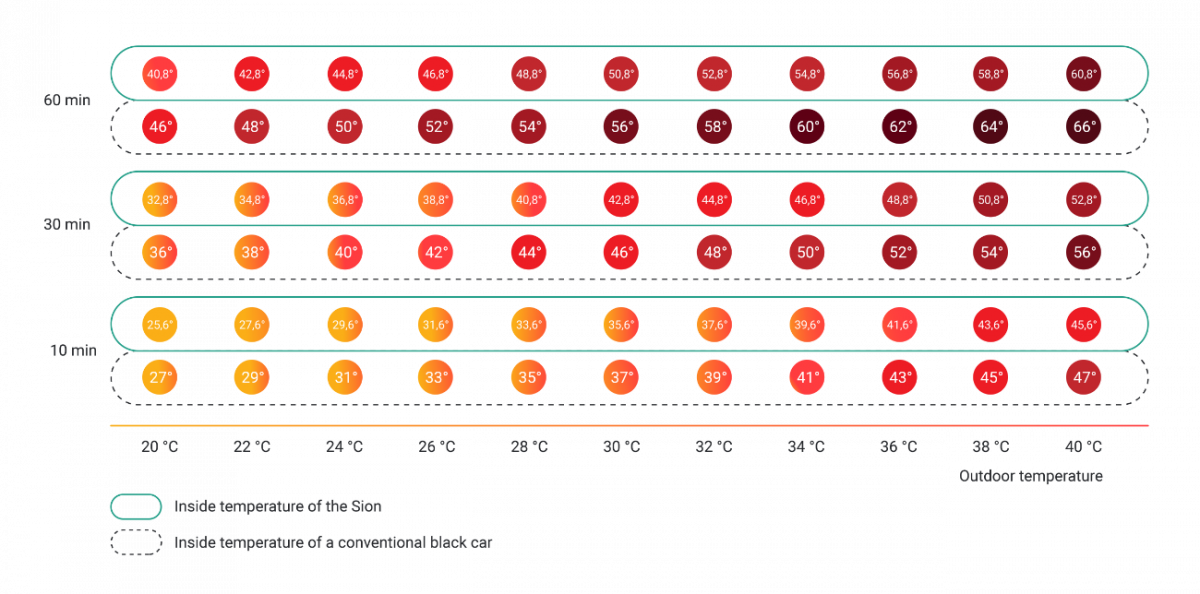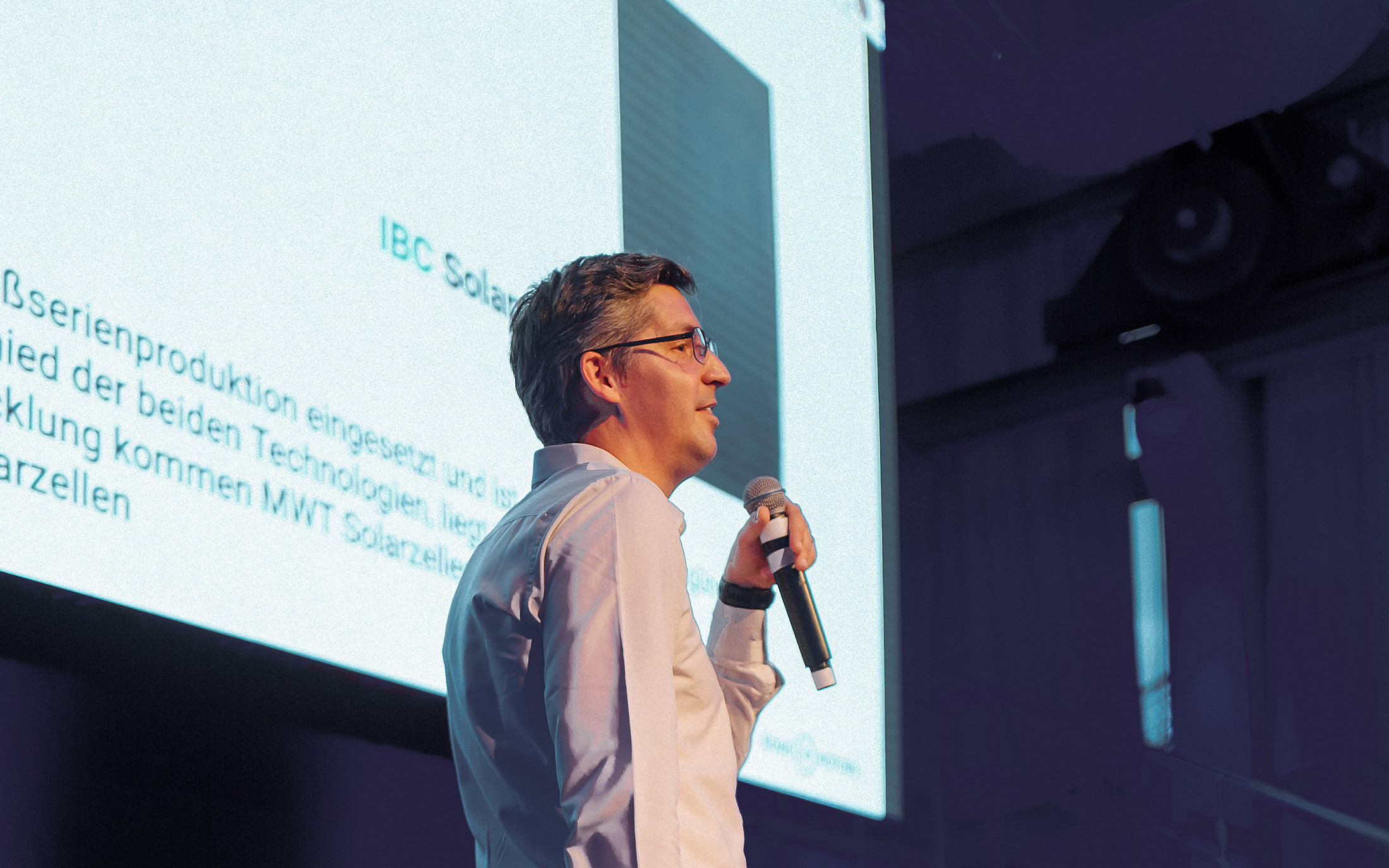To make the best use of solar integration in the Sion, the vehicle should be parked in the sun. But is it worth it at all, or is all the energy generated needed for the air conditioning system to cool the interior? Our community has asked us this question. In this article Mathieu, Director of Photovoltaic Integration, and Christian, Engineer for Photovoltaic Power Electronics, explain in detail how the charging of the battery cells works and how much energy is needed to cool the interior.
Theoretical speaking, the energy of the sun, which we receive on earth within one hour, is sufficient to supply the world population with electricity for a whole year. This energy is freely available without having to resort to finite resources. We use this energy by integrating solar cells into the body of the Sion. The technology is built into the black surface of the vehicle and is hardly visible. What is special about it, is the cell’s integration in the entire body, including the side panels of the vehicle. This results in a total solar cell area of six square meters.
This technology also saves 20 percent in weight compared to conventional car parts. Solar integration enables an additional range of up to 5,800 kilometers per year - without any additional external energy source. In an earlier article by Christian we already reported on the current state of development of solar integration.
Functionality of Charging by Solar Energy
Before we talk about the energy consumption of the Sion’s air conditioning system, we will first go into the functioning of the solar energy charging system.
The artificial intelligence in the MPPT Central Unit, which we developed together with our partners in Spain, measures the strength of the solar radiation at dynamic intervals. If the predefined minimum threshold is reached, from which it is useful to start the charging process (for example at sunrise), the Vehicle Control Unit is activated and the battery's state of charge and cell temperature are, among other things, queried.
Both values must be taken into account for an efficient and battery-saving charging strategy. Not every day 250 kilometers have to be covered. The vehicle owner can determine the upper SOC threshold, i.e. the percentage to which the battery cells should be charged. This makes particular sense with regard to the service life of the battery cells, as they have a longer service life if they are not constantly charged to 100 %.
With conductive charging, for example via the wallbox, it is already possible to configure the SOC threshold via the infotainment system. We have reported on this in the video of a previous blog post on the subject of infotainment systems. If the vehicle owner specifies here that the charging process via the wallbox should end at 80 %, for example, the remaining 20 % could be charged further with solar energy.
At this point we are open for the wishes of the community in the development. Should charging continue via the sun or should the focus be on the service life of the battery cells here as well? Please let us know!
As long as the vehicle control unit gives the basic approval for solar charging, the entire process runs in the background within the defined limits. The infotainment system displays the values for the status of the charge to the vehicle owner.
But what if a cloud covers the sun? Constant starting and stopping of the charging process can be counterproductive for the lifetime of battery components on the one hand, and on the other hand, the system's own consumption must also be taken into account.
Our solution for this is to absorb these fluctuations. Depending on the duration and intensity of the shading, these fluctuations in solar radiation can be bridged without interrupting the charging process. If the weather conditions change over a longer period of time or the sun goes down, the system switches itself off after a certain time.
This function is already integrated in our next prototype, which will be presented at the end of the year. Also, if the sun continues to shine, but the charge level is already at 100 %, the automatic charging system switches itself off. This means that the battery cells cannot be damaged.
Since this mechanism is integrated into the vehicle, it makes sense to park the Sion in direct sunlight for most of the day. In this way, the optimum charging efficiency can be achieved. For example, in Munich in June, the battery cells could be charged within one week using only solar energy, provided that the Sion is parked in open terrain. The long-term effect on the range and operating times of the electronics is particularly decisive for the CO2 footprint. For this purpose, the solar integration of the Sion is perfectly optimized.
What energy is needed to cool the interior?
Back to the initial question of this article: Is it worth parking the Sion in the sun or does it require all the energy generated to cool the interior down? Putting it briefly: Yes, it’s definitely worth it!
Why that is, we will show you here.
First of all, we would like to mention that the Sion, thanks to solar integration, does not heat up as much as a black car with a conventional body. This is because about 22 % of the sun's radiation is converted into energy instead of heat.

Depending on the season and other external influences, the interior heats up differently. Of course, it depends on where the vehicle is parked. The Sion will heat up differently when parked in Munich than when parked in Stockholm or Madrid. The following examples are not generally valid, but depend on various factors such as season, intensity of sunlight and driving style.
In summer in Munich, the Sion's air conditioning system needs 0.7 kWh for ten minutes of cooling at full power. With this 0.7 kWh, the Sion drives five kilometers under test conditions. However, since under optimal conditions on a summer day in Munich, 35 kilometers can be gained through solar integration. Therefore, only 14 % of the energy generated are required. On a slightly cloudy day in summer or when the vehicle is parked in the shade, up to twelve kilometers of additional range can be generated. Since less energy is needed to cool the interior due to the conditions, the consumption values are still in a good ratio to the result.
In spring or fall, on the other hand, the Sion requires only 0.5 kWh of its energy to cool the interior. This 0.5 kWh would correspond to a range of approximately 3.5 kilometers. For example, in March it is very likely to generate 17 additional kilometers per day with solar energy.
In addition to using the air conditioning system, opening the windows, as in other vehicles, can further reduce the energy required for cooling.
In general, under optimal conditions, the following applies: to generate 0.7 kWh from solar energy, the Sion must be parked in the direct sun for 50 minutes. In other words, even if you park the Sion in full sunlight for one hour, more energy is produced than is needed to cool the interior. Therefore, in the long run, it is always worthwhile to park the Sion in the sun rather than in the shade. In this way, the vehicle receives energy from the sun without having to rely on external energy suppliers.
